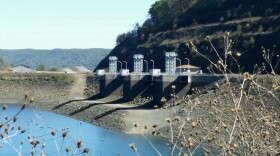Faced with worrisome warnings of climate change, Virginia is weighing green options for producing energy. Solar and wind are sources favored by this state’s two largest utilities, but what about water power? Virginia is blessed with mountains and rivers, not unlike a place where dams provide 60% of the power.

In the mountains of Switzerland water is everywhere. Streams, rivers and lakes flow into the Grande Dixence – the world’s tallest gravity dam. In 1953, 3,000 men started building, and eight years later the project was finished. Today, the dam generates enough electricity to power 400,000 homes.
The area is popular with tourists. One hundred thousand come each year – enough to support a cable car, hotel and restaurant. And now that Switzerland has voted to phase out nuclear power, the nation may depend even more on water.
Switzerland’s population is 8.5 million – just a little smaller than that of Virginia. We, too, are rich in mountain streams and rivers, but the Swiss have something we lack.
“At the end of the valley there are glaciers, and we can get water from many glaciers to fill the dam,” explains Nicola Bretz, a civil engineer who oversees security at Grande Dixence.
It was built at 7,760 feet above sea level – while Virginia’s tallest peak – Mt. Rogers -- is two thousand feet lower than that. Our rivers are not as robust as those of Switzerland, and historically we’ve had access to cheap supplies of coal.
In retrospect, it may be a good thing that we’re not reliant on hydro power. In the age of climate change, glaciers are going away. At the start of the next century, Swiss scientists say 80-90 percent of their ice will be gone.
“One day perhaps we will have no more glaciers,” Bretz says. “Then we’ll have water coming from the skies in the form of rain and snow.”
But area residents say patterns of precipitation are also changing. On a train leaving the nearby town of Sion, we met Marie Anson and her son James.
“When I was a child, for Christmas there was always snow,” Marie recalls. “It was starting around the 7th of December, and now we don’t see snow, sometimes until mid-January.”
“Yeah, you can actually see problems are coming with agriculture and the production of fruits,” James adds.
So there’s some uncertainty in hydropower’s future – and its past was not without problems. Construction of the Grande Dixence meant destruction of ecosystems, and spokeswoman Christel Varone says the project could probably not be built today.
“We have to be very careful with the environment, so maybe it’s today more difficult than years ago.”
So Switzerland has no plans to build more dams but will, instead, rely on other renewable energy sources in the years to come.
So Switzerland has no plans to build more dams but will, instead, rely on other renewable energy sources in the years to come.
So Switzerland has no plans to build more dams but will, instead, rely on other renewable energy sources in the years to come -- solar, wind and conservation.
One more point is worth making. Virginia does have one important dam in Bath County – the largest pumped storage facility in the world. When we have an excess of power, Dominion can pump water to a lake above the dam, and when more energy is needed, it can release that water. Since the sun doesn’t always shine, and the wind doesn’t always blow, that dam could be increasingly important as Virginia makes the transition to clean, renewable energy.
This report, provided by Virginia Public Radio, was made possible with support from the Virginia Education Association.







